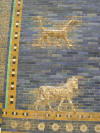Detail of the Ishtar Gate, made of glazed bricks,
which served as an entrance to the city, leading to the
Processional Way in Babylon, built on the orders of King
Nebuchadnezzar II (605 - 562 B.C.). The bull is the
symbol of Adad, the Babylonian god of weather.

A further detail of
the Ishtar Gate, now reconstructed in the Berlin Museum of
Western Antiquities. The original bricks are those
which show wear and are broken or cracked. The "clean"
looking bricks are modern replicas made with the same
original techniques. The dragon depicted represents
the god Marduk, the patron god of the City of Babylon.
"Nebuchadnezzar's Babylon was a mud-brick city, but dazzling
blue-glazed bricks faced the most important monuments.
Some of the buildings, such as the Ishtar Gate, with its
imposing arched opening flanked bytowers, featured glazed
bricks with molded reliefs of animals, real and imaginary.
Glazed bricks had been used earlier but the surface of the
bricks, even those with figures, was flat. On the
surfaces of the Ishtar Gate, laboriously reassembled in
Berlin, are the alternating profile figures of the dragon of
Marduk and the bull of Adad. Lining the processional
way leading up to the gate were the reliefs of Ishtar's
sacred lion, glazed in yellow, brown, [white], and red
against a blue ground. The Babylonian glazes were
opaque and hard. Each brick had to be molded and
glazed separately, then set in the proper sequence on the
wall."
- Gardner's
Art Through The Ages,
11th edition, Vol. I, pp. 37-38

|